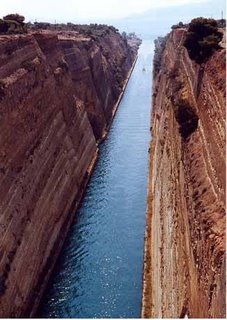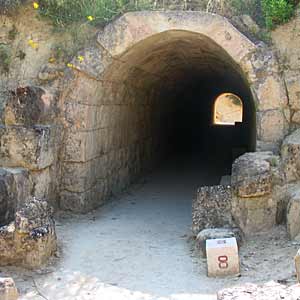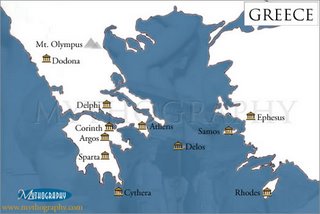Wednesday, May 31, 2006
Corinth and a trip to Olympia

Greetings from Olympia Greece!!
It has been a good day. We visited the site of Corinth. Corinth is an important mainly because of its location near the isthmus with mainland Greece. It had 2 important harbors which it controlled Cenchrea and Lechaion. A great deal of trade traveled through the city. So it control important land and sea routes. This is a site with a long occupation, dating from the Bronze Age like Mycenae. It flourished from the 7th to the 4th centuries BC. It was destroyed by the Roman General Mummius in 144BC. The Romans punished Corinth because they rebelled against Roman authrity. The leveled every building in the town except for the Temple to Apollo.
The town was restructured as a Roman city and it was this town that Paul visited in the first century. He founded a church at the city and wrote 2 letters to the Christians there.
The most impressive structure on the site is the Temple to Apollo it has 7 Doric columns still standing and it is one of the earliest temples in Greece. (it is pictured above).
The remains of a Greek stadium, which the Romans built over while constructing their Forum, is visible in the center of the site. An interesting feature of the site was a a secret staircase where a priest could hide behind a wall and "perform a miracle" by making wine come forth out of the fountain when prompted.
We also saw the Bema of the city which is the likely location of Gallio's address as recorded in Acts when Paul is taken before him and charged with crimes against the Jews of the city. The AcroCorinth rising above the city was the home to the Temple to Aprodite. Her priestess served as Temple prostitutes in the city. The mobile population and this temple led to many of the problems in the Corinth church.
The main road to Lechaion is well preserved and has a large fountain, several shops and even public toliet on either side of the street.
The museum has many important statues and frescos. It also has an inscription from a 5th century synagogue in the city. Corinth had an Askelpion healing center and some of the votive offerings of models of body parts offered to god for healing are on display.
The odeon and theater of the site were closed. But you have a good view of the harbor area from the site. The theater has the important Erastus Inscription which mentions that Erastus a leader in the city paid for a pavement on the east side of the theater.
We ate lunch at a little resturant near the site and then drove about 3-4 hours to this hotel near Olympia. It had a nice view of the valley and water in the distance. I had a Donner Kabab platter which is grilled meat, vegetables, a great yogart, and a few french fries.
I got news when I arrived at the hotel that my bag is in a village about 11 km away. But to get it would cost 30 euro for the cab. 15 there and back. So I talked to the bus driver and he said we could pick it up tomorrow on our way to Olympia. So I decided to be one more day with out my bag. Anyway I am glad that it is hear. I just hope it is my bag, I guess I will find out tomorrow.
Tomorrow we visit Olympia and give a presentation on altars and sacrifice
My new camera worked well and I think it will be fine. I just have to solve the storage problem of all those images I will collect I am thinking of transfering them to an IPOD.
I hope all is well wirtie to me when you get a chance at wineland@kcu.edu
John Wineland, Olympia Greece
Tuesday, May 30, 2006
Nemea and Epidauros

Greetings,
Today we visited Nemea and Epidauros.
Nemea was home to the Nemean games one of the four Panhellenic Games. It has a large temple to Zeus see picture above, which is being restored. About 7 Doric columns now stand at the site. It also has a large Greek/Hellenistic bath complex with ancient sinks still standing in situ. The museum is a good with with several artifacts from the site and the surrounding area. They have a good video on the way the ancient footraces were conducted at the stadium. The starting line is well preserved as well as an earliest known arched vault which served as entranceway for the athletes. This site has been excavated by the University of California, Berkeley for many years. http://ist-socrates.berkeley.edu/~clscs275/
We had lunch at large roadside cafe which is designed for bus groups I had grilled chicken kebab with rice and a nice Greek salad.
Then we went to Epidauros which has the best preserved Greek theater. It is amazing with wonderful acoustics. It dates to the 4th century BC. It has a circular orchesta it would seat about 10,000 people and it was enlarged in the Roman period.
The site also has a ancient healing center called an Asklepieon which was dedicated to Asklepios the son of Apollo. He is connected with snakes esp large yellow Python. It is his symbol of the snake wrap around the staff that the American Medical Association still uses. The Ancient Greeks believed that the Python taught Asklepios the secrets of healing and medicine. People would come to the shrine for healing and later for surgery.
The site has a tholos or round building which might have housed snakes which were used in ceremonies.
Later we returned to the beautiful town of Nafplion. I walked a long ways in search of a new digital camera which I found. Then I had a chicken gyro at a small cafe before returning to learn more about my camera and post to the blogs.
The airline website reports that my bag has arrived at the airport but it does not say which airport and exactlu when it arrived. But I am now more optimistic that I will see my bag again. I hope tomorrow but if not perhaps the next day. We change hotels tomorrow and we will ancient Corinth on our way to Olympia, home of the ancient Olympic games. I hope my luggage catches up with me there.
John Wineland, Nafplion, Greece
Monday, May 29, 2006
Overview of the Project
We are traveling for about two weeks in Greece and staying at four locations,
1. Nafplion for 3 nights
We will visit the following sites during this time in this order
Mycenae and museum
Nemea
Epidauros
2. Olympia for 2 nights
We will visit the following sites during this time in this order
Corinth
Olympia and museum
3. Delphi for 2 nights
Delphi and museum
4. Athens for 6 nights
We will visit the followinf sites during time and in this order
Marathon
Athenian Acropolis
National Museum
Athenian Agora
Kerameikos
Panathenaia
Eleusis
Aegina
Trip to Greece
We drove by bus to our hotel in Nafplion and had dinner. It is a sea side town.
This morning we had some lectures and discussion about Ancient Greek religion.
This afternoon we are off to Mycenae.









